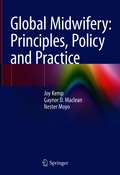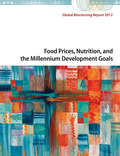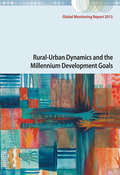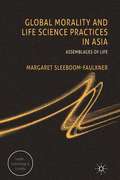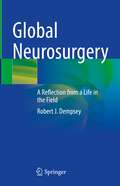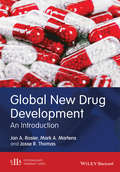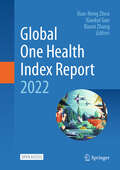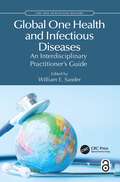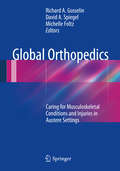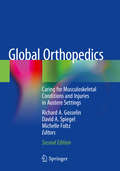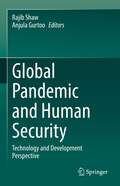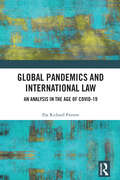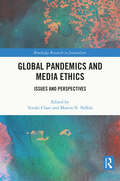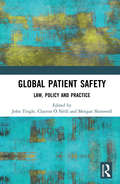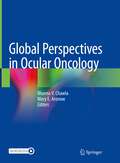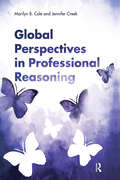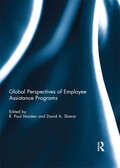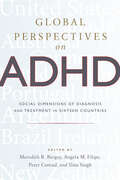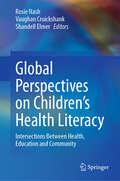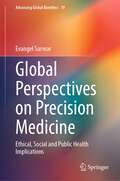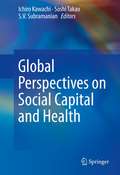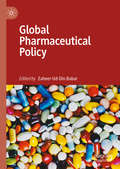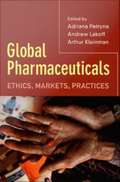- Table View
- List View
Global Midwifery: Principles, Policy and Practice
by Joy Kemp Gaynor D. Maclean Nester MoyoThis textbook is the first authoritative, in-depth publication about global midwifery and the contribution of skilled professional midwives to the provision of high quality maternity care, reductions in maternal and newborn mortality and morbidity. It demonstrates actions that are contributing to the achievement of the 2030 Sustainable Development Goals through partnership with women and their families, enabling them to ‘survive, thrive and transform’.The textbook explores how the world is becoming more connected through globalisation, advances in technology and innovation and yet more inequitable as women and children are disproportionately affected by issues such as poverty, environmental vulnerability, hunger, conflict, violence, and discrimination. It considers how midwives contribute to maternal and newborn health, leading to greater equity and empowerment and, ultimately, strengthening health systems.The ‘three pillars’ of midwifery are discussed: regulation, education and professional midwives’ associations. The importance of evidence-based care is explored along with diff erent models of midwifery and the challenges of developing professional leadership. This textbook also considers women’s human rights to sexual and reproductive health and respectful maternity care, stressing the importance of cultural sensitivity and contextually appropriate approaches.Midwives and other professionals will benefi t from this reliable resource that indicates direction and provides information about the principles and practice of professional midwifery. This text also provides universities, organisations, and individuals with a highly relevant resource to better equip them for international midwifery practice. It finally offers policy makers a reliable source of evidence-based information for consideration in various evolving national and international situations.
Global Monitoring Report 2012
by World Bank International Monetary FundWhat has been the impact of yet another food price spike on developing countries' ability to make progress toward the Millennium Development Goals (MDGs)? How many poor people have been prevented from lifting themselves out of poverty? How many people, and how many children, have seen their personal growth and development permanently harmed because their families could not afford to buy food? Finally, what can countries do to respond to higher and more volatile food prices? Global Monitoring Report 2012: Food Prices, Nutrition, and the Millennium Development Goals examines these questions. It summarizes the effects of food prices on several MDGs, stressing that recent food price spikes have prevented millions of households from escaping extreme poverty. The report advocates using agricultural policy to orchestrate a supply response; deploying social safety nets to improve resilience; strengthening nutritional policy to manage the implications of early childhood development; and implementing trade policy to improve access to food markets, reduce volatility, and induce productivity gains. The report acknowledges that one size does not fit all and that the sequencing and prioritization of various policy initiatives depend critically on the initial situation a country or region finds itself in. It also discusses support by the international community. The world has met two global MDG targets well before the 2015 deadline. Estimates based on preliminary surveys indicate that the share of people living in extreme poverty in 2010 was half what it was in 1990. The world has also halved the share of people with no safe drinking water. The goal of gender parity in primary and secondary education is on track to be met in 2015, and the goal of ensuring that children everywhere--boys and girls alike--are able to complete primary school is nearly on track. But the MDGs closely linked to food and nutrition, particularly those that aim to reduce child and maternal mortality, are lagging. Global Monitoring Report 2012 was prepared jointly by the World Bank and the International Monetary Fund, with consultations and collaborations with regional development banks and other multilateral partners.
Global Monitoring Report 2013: Rural-Urban Dynamics and the Millennium Development Goals
by the editors at The World BankThe Global Monitoring Report 2013: Rural-Urban Dynamics and the Millennium Development Goals examines rural-urban disparities in the achievement of the Millennium Development Goals (MDGs) and how urbanization, if managed well, can contribute to the attainment of these goals. The report provides information about the differences in progress toward the MDGs across geographical areas and recognizes that urban populations are better off than their rural brethren. However, unfettered urbanization can cause migrants and the urban poor to end up in slums where attainment of the MDGs lags. GMR 2013 calls for an integrated strategy to better manage the planning-connecting-financing formula of urbanization. Notwithstanding the importance of urbanization in poverty reduction and MDG attainment, rural areas remain a huge challenge—one that underscores the importance of policies that can improve rural livelihoods. The rural-urban spectrum ranges from small towns to large cities. The general experience is that poverty is lowest in the largest cities and considerably higher in smaller towns. The MDGs reflect the basic needs of all citizens, and governments should aim to meet them fully in both urban and rural areas. However, resources are scarce, so priorities must be set and trade-offs made. The report argues that the sequencing of actions be tailored to local conditions when it comes to the degree of urbanization and rural-urban differences in MDG outcomes. The world has met four global MDG targets. New estimates confirm the 2012 reports that MDG 1.a—reducing the $1.25-a-day poverty rate (2005 purchasing power parity)—was reached in 2010, falling below half of its 1990 value. The world also met part of MDG 7.c—to halve the proportion of people without safe access to drinking water—in 2010. MDG 7.d—to improve significantly the lives of at least 100 million slum dwellers by 2020—was also achieved. Finally, the first part of MDG 3.a—to eliminate gender disparity in primary education— was accomplished in 2010. Global progress on the full MDG 3.a (to eliminate gender disparity in primary and secondary education) is close to being on track. Global Monitoring Report 2013 was prepared jointly by the World Bank and the International Monetary Fund, with consultations and collaborations with regional development banks and other multilateral partners. Show more
Global Morality and Life Science Practices in Asia
by Margaret Sleeboom-FaulknerEmpirical studies of life science research and biotechnologies in Asia show how assemblages of life articulate bioethics governance with global moralities and reveal why the global harmonization of bioethical standards is contrived.
Global Neurosurgery: A Reflection from a Life in the Field
by Robert J. DempseyDuring his training, neurosurgeon Robert J. Dempsey, M.D. was told that global health was something for infectious diseases and not possible in super-specialties. This is the story of questioning that belief, of addressing a massive need by working in the areas of need, going to numerous ministers of health worldwide and showing them that with the training of even a few neurosurgeons, we can complete a trauma system in their country. The result is now we can also provide care for cancer, stroke and congenital defects of newborn children where it was previously impossible. In 2015, the Lancet Commission’s report predicted, over the next few years, 47 million unnecessary deaths worldwide due to the lack of essential surgeries. This book relates the importance of rectifying that ongoing tragedy and, more importantly, the humanizing influences that such a journey has had on a super-specialist working with the people of greatest need. It concludes that in spite of massive need, the present situation is actually very hopeful, as we have shifted the focus of global health from service alone to partnered teaching, leading us now to self-sustaining systems of care delivered for and by the people in the regions of need. Global Neurosurgery covers the thought-provoking and often frightening lessons learned over four decades of neurosurgical involvement in global health, working from a period when little or none existed to the present state of specialized healthcare in the area of need. This process starts in the U.S. and then addresses health disparity on four continents and now on U.S. tribal reservations. It emphasizes the importance of first listening, then partnering with government, medical societies, universities and private foundations, and most importantly, learning from mistakes. The programs developed allow the recipients of the care to take over the training so that it becomes about them and their patients in their home lands. It will appeal to a wide audience because its stories explain actual worldwide health conditions while giving an insight valuable to the professional or lay person into the experiences and operating rooms of a neurosurgeon working under very difficult conditions.
Global New Drug Development: An Introduction (Postgraduate Pharmacy Series)
by Jan A. Rosier Josse R. Thomas Mark A. MartensThe development of new drugs is very complex, costly and risky. Its success is highly dependent on an intense collaboration and interaction between many departments within the drug development organization, external investigators and service providers, in constant dialogue with regulatory authorities, payers, academic experts, clinicians and patient organizations. Within the different phases of the drug life cycle, drug development is by far the most crucial part for the initial and continued success of a drug on the market. This book offers an introduction to the field of drug development with a clear overview of the different processes that lead to a successful new medicine and of the regulatory pathways that are used to launch a new drug that are both safe and efficacious. "This is the most comprehensive and detailed book on drug development I have ever read and I feel that it is likely to become a staple of drug development courses, such as those taught at Masters Level in my own University.... I think in the light of increasing integration of company and academic approaches to drug development both sides can read this book... (and, therefore)... this book could not be more timely."—Professor Mike Coleman, University of Aston, UK ( from his review of the final manuscript)
Global One Health Index Report 2022
by Xiaoxi Zhang Xiao-Nong Zhou Xiaokui GuoThis Open Access book intends to report the new results of the Global One Health Index (GOHI). The content of this book underlines the functions and importance of developing the evaluation tool (GOHI) for global One Health practice, shows the results of GOHI score in 160 countries/territories and key findings in details, and provides different policy recommendations to UN agencies, countries, and communities to promote the wide application of the One Health approach. A pilot study was conducted in 2021, and its related publications are collected in one section of the book. The book is likely to be of interest to researchers, practitioners, policy-makers, and stakeholders in applying One Health who wish to learn about the development, results, key findings, and policy recommendations of GOHI study.
Global One Health and Infectious Diseases: An Interdisciplinary Practitioner’s Guide (CRC One Health One Welfare)
by William E. SanderWhile many terms relate to One Health, the idea remains the same: to think outside a chosen area of specialty and work collaboratively as part of a team to improve health status around the world. This involves the collective effort of physicians, veterinarians, public health practitioners, ecologists, anthropologists, social workers, economists, and many others. Collectively, these are the Global One Health practitioners.Through the lens of infectious disease, this book brings together the diverse range of topics necessary to be an effective global health practitioner at the intersection of human and animal health, particularly in developing countries. It explores what an aspiring or mid-career practitioner should be aware of when working with infectious diseases, including technical skills, cultural competency, capacity building, big data, and understanding the landscape and history of global health. Each chapter focuses on a specific area of necessary knowledge with background information, case examples, and resources to use moving forward.An important reference for upper-level undergraduate students, graduate students, and early practitioners in human, animal, and public health, this text highlights the competencies rather than focusing on the problems in Global One Health. It provides a blueprint of areas that the reader should pay attention to, particularly in the realm of infectious diseases.Chapter 13 ‘One Health Education, Training, and Capacity Building’ is available to read Open Access at https://www.taylorfrancis.com/books/9781032140674.
Global Orthopedics
by Richard A. Gosselin David A. Spiegel Michelle FoltzGlobal Orthopedics: Caring for Musculoskeletal Conditions and Injuries in Austere Settings was conceived and written to be a unique reference for surgeons working in resource-limited environments. The first sections provide historical background, global public health perspectives of orthopedics, the role of culture, and a broad discussion of clinical topics that orthopedic surgeons rarely deal with in high-resource settings but that affect orthopedic care. Adult and pediatric trauma are presented in an anatomical format for easy reference, with a focus on the natural history and the best treatment methods within existing limitations. The chapters on musculoskeletal infections provide a focused discussion about these common debilitating conditions that is unavailable in any other single modern text. The non-infectious pediatric conditions section has been written for the non-specialist to handle selected developmental and early childhood orthopedic problems commonly seen in low-resource settings. Detailed chapters on reconstruction surgery, tumor management, amputations, and the orthopedic needs in the face of conflicts and natural disasters round out the text
Global Orthopedics: Caring for Musculoskeletal Conditions and Injuries in Austere Settings
by Richard A. Gosselin David A. Spiegel Michelle FoltzNow in a revised and expanded second edition, this unique text discusses the opportunities and challenges to the practice of orthopedic surgery in resource-limited environments around the world. Sensibly divided into thematic sections, part I examines barriers to care, from the poorly recognized global burden of orthopedic conditions and the less than ideal equipment to the cultural considerations and ethical dilemmas inherent in such situations. General clinical topics are covered in part II, such as non-surgical approaches and anesthesia, while the remaining sections discuss adult and pediatric trauma, presented in an anatomical format for easy reference with a focus on the natural history and the best treatment methods within existing limitations, followed by musculoskeletal infections, non-infectious pediatric conditions, reconstruction, and amputations. Topics new to this edition include the management of non-unions by induced membrane techniques, autologous bone grafting, bone growth and burn charts, the management of neck and back pain, and principles of orthopedic rehabilitation. Written and edited by experts with years of experience working in austere settings, this second edition of Global Orthopedics is a seamless transition from the original and expands the range of possible management strategies in places desperate for orthopedic care, making it a must for all surgeons and practitioners planning to work in such challenging settings.
Global Pandemic and Human Security: Technology and Development Perspective
by Rajib Shaw Anjula GurtooThis book highlights how the human security aspect has been affected by the global pandemic, based on the specific case study, field data, and evidence. COVID-19 has exemplified that the pandemic is global, but its responses are local. The responses depend on national governance and policy framework, use of technology and innovation, and people’s perceptions and behavior, among many others. There are many differences in how the pandemic has affected the rich and the poor, urban and rural sectors, development and fiscal sectors, and developed and developing nations and communities.Echoing human security principles, the 2030 Agenda emphasized a “world free of poverty, hunger, disease and want… free of fear and violence… with equitable and universal access to quality education, health care, and social protection….to safe drinking water and sanitation… where food is sufficient, safe, affordable and nutritious… where habitats are safe, resilient and sustainable…and where there is universal access to affordable, reliable and sustainable energy.” These basic human security [PA1] principles and development agenda are highly affected by the global pandemic worldwide, irrespective of its development and economic status. Thus, the book highlights the nexus between human security and development issues. It has two major pillars, one is the development and the other is technology issues. These two inter-dependent topics are discussed in the perspective of the global pandemic, making this the most important feature of this book.While the world is still in the middle of a pandemic, and possibly other natural and biological hazards may affect peoples’ lives and livelihoods in the future, this book provides some key learning, which can be used to cope with future uncertainties, including climate risks. Thus, the book is timely and relevant to wider readers.
Global Pandemics and International Law: An Analysis in the Age of Covid-19
by Ilja PavoneThis book reviews the efficacy of Global Health Law, assessing why its legal framework based on the International Health Regulations did not represent a valid tool in the containment of modern global pandemics such as COVID-19. The book provides an introduction to the international legal framework surrounding epidemics and pandemics and the main global governance issues that have been generated by the COVID-19 outbreak. It highlights the main shortcomings of Global Health Law, while also including practical proposals to improve the WHO’s mechanism to prevent and respond to future disease outbreaks, such as the New Pandemic Treaty. Emphasis is placed on what has not worked in the international, regional and national responses to COVID-19. It is argued that the pandemic has shed light on the weaknesses of global and domestic health law. By identifying legal gaps and providing legal arguments, the book contributes to the historical and conceptual foundation as well as the practical development of international law in the new age of COVID-19, with the ultimate goal of stimulating legal reform in this vital new era. The work will be essential reading for academics, researchers and policy-makers working in International Law, Health Law, Environmental Law, Human Rights Law, Biolaw, and the Law of International Organizations.
Global Pandemics and Media Ethics: Issues and Perspectives (Routledge Research in Journalism)
by Tendai Chari Martin N. NdlelaThis topical volume illuminates ethical issues brought to the fore by the COVID-19 pandemic. Drawing on a broad range of case studies from different regions, it provides insights into the multiple and complex ways in which the pandemic has shaped media ethics. The chapters employ a wide range of innovative theoretical and methodological approaches to dissect enduring and emerging ethical questions during the pandemic, providing lucid accounts of axiological dimensions in pandemic discourses, ethics of emotional mood, ethical challenges and dilemmas in news reporting, propaganda, misinformation, disinformation and Othering. While the case studies in this book are unique, the authors have extrapolated common strands from their analysis of ethical issues applicable to any other country or region during the pandemic, contributing unique perspectives on how media ethics are circumscribed by global health pandemics. The book will appeal to researchers, academics and practitioners at all levels in the fields of media studies, journalism, communication, media sociology and public health, as well as general readers and policymakers who are keen to learn more about how global health crises illuminate critical ethical issues confronting the media.
Global Patient Safety: Law, Policy and Practice
by John Tingle Clayton Ó Néill Morgan ShimwellThis book explores patient safety themes in developed, developing and transitioning countries. A foundation premise is the concept of ‘reverse innovation’ as mutual learning from the chapters challenges traditional assumptions about the construction and location of knowledge. This edited collection can be seen to facilitate global learning. This book will, hopefully, form a bridge for those countries seeking to enhance their patient safety policies. Contributors to this book challenge many supposed generalisations about human societies, including consideration of how medical care is mediated within those societies and how patient safety is assured or compromised. By introducing major theories from the developing world in the book, readers are encouraged to reflect on their impact on the patient safety and the health quality debate. The development of practical patient safety policies for wider use is also encouraged. The volume presents a ground-breaking perspective by exploring fundamental issues relating to patient safety through different academic disciplines. It develops the possibility of a new patient safety and health quality synthesis and discourse relevant to all concerned with patient safety and health quality in a global context.
Global Perspectives in Ocular Oncology
by Bhavna V. Chawla Mary E. AronowEye cancers vary in presentation depending upon geographic location and access to healthcare. Global Perspectives in Ocular Oncology offers an international platform for leading ocular oncologists and multidisciplinary specialists to highlight worldwide strengths and solutions to the challenges in treating eye cancer. The goal of the book is to provide a universal view on the management of adult and pediatric tumors affecting the eye and ocular adnexa. A range of topics pertinent to the global community have been included. Organized into seven distinct sections, this book covers international collaborations and initiatives, technology and innovations, and novel treatment strategies. In addition, it provides a glimpse into the future of the specialty. The emphasis on sharing perspectives as well as the global and multidisciplinary framework of the book are unique to the market. This work will appeal to a variety of audiences including ocular oncologists and ophthalmic subspecialists, oncologists and other specialists, optometrists, geneticists, allied medical professionals, and trainees entering these disciplines.
Global Perspectives in Professional Reasoning
by Jennifer Creek Marilyn B. ColeGlobal Perspectives in Professional Reasoning is the first text of its kind to address the broader scope of occupational therapy practice and the different types of professional reasoning that can be employed, including strategic, political, nonlinear, creative, and social reasoning. This text encompasses a wide range of thinking skills and cognitive processes used by occupational therapists, from reflecting on practice to solving problems, and from reasoning in the clinic to reasoning in the wider political, social, and cultural worlds.Marilyn B. Cole and Jennifer Creek and their contributors are therapists, educators, and scholars who have explored new areas of professional practice and written about the thought processes that reinforced their actions. The authors come from around the world, providing a global perspective while also demonstrating that occupational therapists within different cultures serve remarkably similar human needs: to be included in their communities, to have occupational choices, and to determine their own life course.Many of the contributors in Global Perspectives in Professional Reasoning have identified and analyzed their own thought processes as they tackled complex and challenging tasks, often in unfamiliar contexts. These challenging tasks have produced several entirely original conceptualizations of professional reasoning, such as development and spiritual reasoning. The contributors start by observing what is going on, try to make sense of the situation, and then work out what to do. Other contributors are fascinated by a theory, a policy, or an approach; study it; and then look for ways to utilize it in practice. Most of the time, contributors focus their attention on the process of reasoning rather than on the specific types of reasoning they are employing or on desired outcomes.Inside Global Perspectives in Professional Reasoning, each chapter charts the learning process that contributors went through as they extended their thinking skills and processes to meet the challenges they encountered. All the chapters describe reasoning in practice and all of them utilize theory. A broad and fresh take on professional reasoning in occupational therapy practice, Global Perspectives in Professional Reasoning is the perfect resource for occupational therapy students and clinicians who want to utilize reasoning to tackle the most complex and challenging of tasks.
Global Perspectives of Employee Assistance Programs
by R. Paul Maiden and David A. ShararGlobal Perspectives of Employee Assistance Programs is the first book of its kind to empirically address the Employee Assistance Program (EAP) concept and model in a diverse, global context. This book features a variety of studies which deal with the design, delivery, cultural adaptability, evaluation, and measurement of international employee assistance programs in a truly global variety of settings. Contributors also evaluate the impact of EAP on expatriates, the potential for an international well-being assessment tool, and the training of international EAP professionals. This book was originally published as a special issue of the Journal of Workplace Behavioral Health.
Global Perspectives of Toxic Metals in Bio Environs: Volume 1: Environmental Impact, Ecotoxicology, Health Concerns, and Modelling
by Rouf Ahmad Bhat Mohammad Aneesul Mehmood Gowhar Hamid DarThis book explores recent advances in heavy metal contamination research in a global context, and focusses on the role of recent technologies like recombinant bioremediation, phytoremediation, DNA technology and nanotechnology to provide sustainable managing strategies to mitigate adverse environmental and health impacts. Many heavy metals are used in industrial and commercial sectors, including iron, zinc, tin, lead, copper, tungsten, cadmium, arsenic, chromium, thallium, and lead, which, when disposed in the natural environment, lead to serious threats to ecological balance in biotic systems and threaten vulnerable human populations. Currently, global scientific communities are very worried about the detrimental health effects of these heavy metals and their adverse effects on almost all biological systems. Scientific research has recorded some alarming adverse impacts of heavy metals on biota like carcinogenesis, mutagenesis, teratogenesis, allergic interactions, endocrine-disruption, bone marrow damage, osteoporosis. and immune system damage. This book is therefore timely, and will be of interest to researchers, students professors, and policymakers examining toxic heavy metals in the environment and their adverse health impacts.
Global Perspectives of Toxic Metals in Bio Environs: Volume 2: Biotransformation, Remediation and Technological Advances
by Rouf Ahmad Bhat Mohammad Aneesul Mehmood Gowhar Hamid DarThis volume serves as the solution-oriented counterpart to volume 1&’s exploration of environmental impact and health implications. By examining microbial, plant-based, and technological methods of remediation, this volume empowers researchers, practitioners, and policymakers with actionable insights. The final chapters in Volume II call for global collaboration and thus uniting the two volumes in a commitment to holistic, sustainable management of toxic metals in the environment. Volume II builds on the insights of Volume I by exploring solutions and technological advancements for tackling these toxic metals. It covers the biotransformation processes that toxic metals undergo in biological environments, which can either exacerbate or mitigate their harmful effects. Furthermore, it delves into the remediation technologies and biotechnological innovations aimed at detoxifying affected environments and preventing future contamination. Together, the two volumes provide a holistic view, with Volume I offering the problem analysis and Volume II presenting practical solutions, making them ideal resources for understanding both the theoretical and applied aspects of managing toxic metals in environmental systems. The first volume frames the scope and urgency of the problem, while the second volume provides viable solutions and forward-looking perspectives.
Global Perspectives on ADHD: Social Dimensions of Diagnosis and Treatment in Sixteen Countries
by Edited by Meredith R. Bergey, Angela M. Filipe, Peter Conrad, and Ilina SinghExamining ADHD and its social and medical treatments around the world.Attention deficithyperactivity disorder (ADHD) has been a common psychiatric diagnosis in both children and adults since the 1980s and 1990s in the United States. But the diagnosis was much less common—even unknown—in other parts of the world. By the end of the twentieth century, this was no longer the case, and ADHD diagnosis and treatment became an increasingly widespread global phenomenon. As the diagnosis was adopted around the world, the definition and treatment of ADHD often changed in the context of different psychiatric professions, medical systems, and cultures. Global Perspectives on ADHD is the first book to examine how this expanding public health concern is diagnosed and treated in 16 different countries. In some countries, readers learn, over 10% of school-aged children and adolescents are diagnosed with ADHD; in others, that figure is less than 1%. Some countries focus on medicating children with ADHD; others emphasize parent intervention or child therapy. Showing how a medical diagnosis varies across contexts and time periods, this book explains how those distinctions shape medical interventions and guidelines, filling a much-needed gap by examining ADHD on an international scale. Contributors: Madeleine Akrich, Mari J. Armstrong-Hough, Meredith R. Bergey, Eugenia Bianchi, Christian Bröer, Peter Conrad, Claire Edwards, Silvia A. Faraone, Angela M. Filipe, Alessandra Frigerio, Valéria Portugal Gonçalves, Linda J. Graham, Hiroyuki Ito, Fabian Karsch, Victor Kraak, Claudia Malacrida, Lorenzo Montali, Yasuo Murayama, Sebastián Rojas Navarro, Órla O'Donovan, Francisco Ortega, Mónica Peña Ochoa, Brenton J. Prosser, Vololona Rabeharisoa, Patricio Rojas, Tiffani Semach, Ilina Singh, Rachel Spronk, Junko Teruyama, Masatsugu Tsujii, Fan-Tzu Tseng, Manuel Vallée, Rafaela Zorzanelli
Global Perspectives on Children's Health Literacy: Intersections Between Health, Education and Community
by Rosie Nash Vaughan Cruickshank Shandell ElmerThis book examines global perspectives of health literacy development to explore the intersections between health, education, and community settings. International health literacy experts provide a collection of important insights and recommendations that are urgently required to inform practice and policy. The impetus for this book is a growing recognition that a siloed approach to supporting health and health literacy exists in many countries. This book addresses a gap in the international literature by presenting solutions that promote ongoing collaboration across settings to redress inequity and optimize global health. Identifying intersections between the settings is critically important to supporting these collaborations. Health literacy is the ability to find, use, evaluate and apply information to look after our health. Developing the personal asset of health literacy earlier in life influences adult health behaviours. A Health in All Policies approach has been globally endorsed; however, a health literacy in all settings approach is yet to be realised. As a social determinant of health, health literacy can determine health outcomes, educational attainment, social equity, and productivity. The authors investigate the health literacy development of children and their communities within particular regions, exploring whether health literacy is addressed as a health, education or community issue. They describe where silos exist between and within settings, aiming to highlight areas where health literacy is present. This helps identify challenges and opportunities for optimizing health literacy development. Global Perspectives on Children's Health Literacy is essential reading for public health and health promotion researchers and practitioners, primordial prevention researchers, policy makers, health and education ministers, community service ministers, youth organisations, librarians, school teachers, health and physical education teachers, school nurses, child and parenting services nurses, paediatricians, and allied health professionals who work with children and families (e.g., social workers, speech pathologists, dietitians).
Global Perspectives on Precision Medicine: Ethical, Social and Public Health Implications (Advancing Global Bioethics #19)
by Evangel SarwarThis book presents the promises of Precision Medicine (PM) and the challenges of its implementation in daily clinical routine, while addressing the anticipated ethical and social implications. It is the first book that critically analyzes the potential and the dilemmas relevant to genomics and precision medicine from healthcare, public health and global perspectives. The nine chapters presented in this book elaborate on pharmacogenomics' crucial role in maximizing the potential benefits and minimizing medication's potential risks in groups of people, especially in cancer treatment and other health conditions. Infectious and non-communicable diseases (NCDs) are also discussed in this book by identifying challenges and ways to overcome them. Essential concepts are addressed, such as health-related benefits and harm to individuals and the broader community, including threats to individual privacy and autonomy, which warrant just distribution of scarce resources. The book also identifies and addresses the lack of competency in the healthcare workforce in the era of PM and discusses the path to laying the ethical foundation for the implementation of PM in healthcare organizations.
Global Perspectives on Social Capital and Health
by Ichiro Kawachi S. V. Subramanian Soshi TakaoThis book is a follow up to Social Capital and Health (2008), edited by Kawachi, Subramanian & Kim. Global Perspectives on Social Capital and Health provides a timely update on emerging topics in a fast-growing field, and features contributions from an outstanding international team of scholars, selected from a diverse range of disciplinary backgrounds including: social epidemiology, medical geography, social psychology, social welfare and gerontology, pediatrics, political science, economics, and medical sociology. The book is organized in three parts: Part 1. Emerging directions in social capital research. This section highlights novel directions in social capital research. These include: a) novel settings for conducting research on social capital (workplaces, schools), b) new approaches for causal inference in social capital (instrumental variable analysis, twin fixed effects designs); c) cutting-edge directions for social capital research, including studies of the origins of community social capital, the use of social network analysis to investigate social capital, and novel methods for investigating the link between social capital and crime. Part 2. Social capital and health policy. The three chapters in this section highlight implications of social capital for interventions and health policy. Part 3. Social capital and health in global perspective The four chapters in this section look at research on social capital and health from a global perspective. The authors summarize the empirical studies on social capital and health conducted in each country/region, or each population group; discuss how the concept of social capital "translates" across different cultures; and identify challenges and future directions for research.
Global Pharmaceutical Policy
by Zaheer-Ud-Din BabarMedicines are vital in improving patient health outcomes and pharmaceutical policy is a fundamental component of any health system. However, the global pharmaceutical policy is ever-evolving and data and quality ‘research-based information’ in this field are scarce. This book fills this gap and provides up-to-date empirical information and evidence-based synthesis. It focuses on pertinent key issues in global pharmaceutical policy including medicines safety, generic medicines, pharmaceutical supply chain, medicines financing, access and affordability of medicines, rational use of medicines, pharmacy health services research and access to vaccines and biological products. Featuring policy case studies from varied countries such as Mexico, Russia, China, Kyrgyzstan, and Pakistan, this book comprises a valuable and comprehensive resource for students, funders, policymakers, academics, and researchers interested in this field.
Global Pharmaceuticals: Ethics, Markets, Practices
by Arthur Kleinman Adriana Petryna Andrew LakoffIn some parts of the world spending on pharmaceuticals is astronomical. In others people do not have access to basic or life-saving drugs. Individuals struggle to afford medications; whole populations are neglected, considered too poor to constitute profitable markets for the development and distribution of necessary drugs. The ethnographies brought together in this timely collection analyze both the dynamics of the burgeoning international pharmaceutical trade and the global inequalities that emerge from and are reinforced by market-driven medicine. They demonstrate that questions about who will be treated and who will not filter through every phase of pharmaceutical production, from preclinical research to human testing, marketing, distribution, prescription, and consumption. Whether considering how American drug companies seek to create a market for antidepressants in Japan, how Brazil has created a model HIV/AIDS prevention and treatment program, or how the urban poor in Delhi understand and access healthcare, these essays illuminate the roles of corporations, governments, NGOs, and individuals in relation to global pharmaceuticals. Some essays show how individual and communal identities are affected by the marketing and availability of medications. Among these are an exploration of how the pharmaceutical industry shapes popular and expert understandings of mental illness in North America and Great Britain. There is also an examination of the agonizing choices facing Ugandan families trying to finance AIDS treatment. Several essays explore the inner workings of the emerging international pharmaceutical regime. One looks at the expanding quest for clinical research subjects; another at the entwining of science and business interests in the Argentine market for psychotropic medications. By bringing the moral calculations involved in the production and distribution of pharmaceuticals into stark relief, this collection charts urgent new territory for social scientific research. Contributors. Kalman Applbaum, Joo Biehl, Ranendra K. Das, Veena Das, David Healy, Arthur Kleinman, Betty Kyaddondo, Andrew Lakoff, Anne Lovell, Lotte Meinert, Adriana Petryna, Michael A. Whyte, Susan Reynolds Whyte
